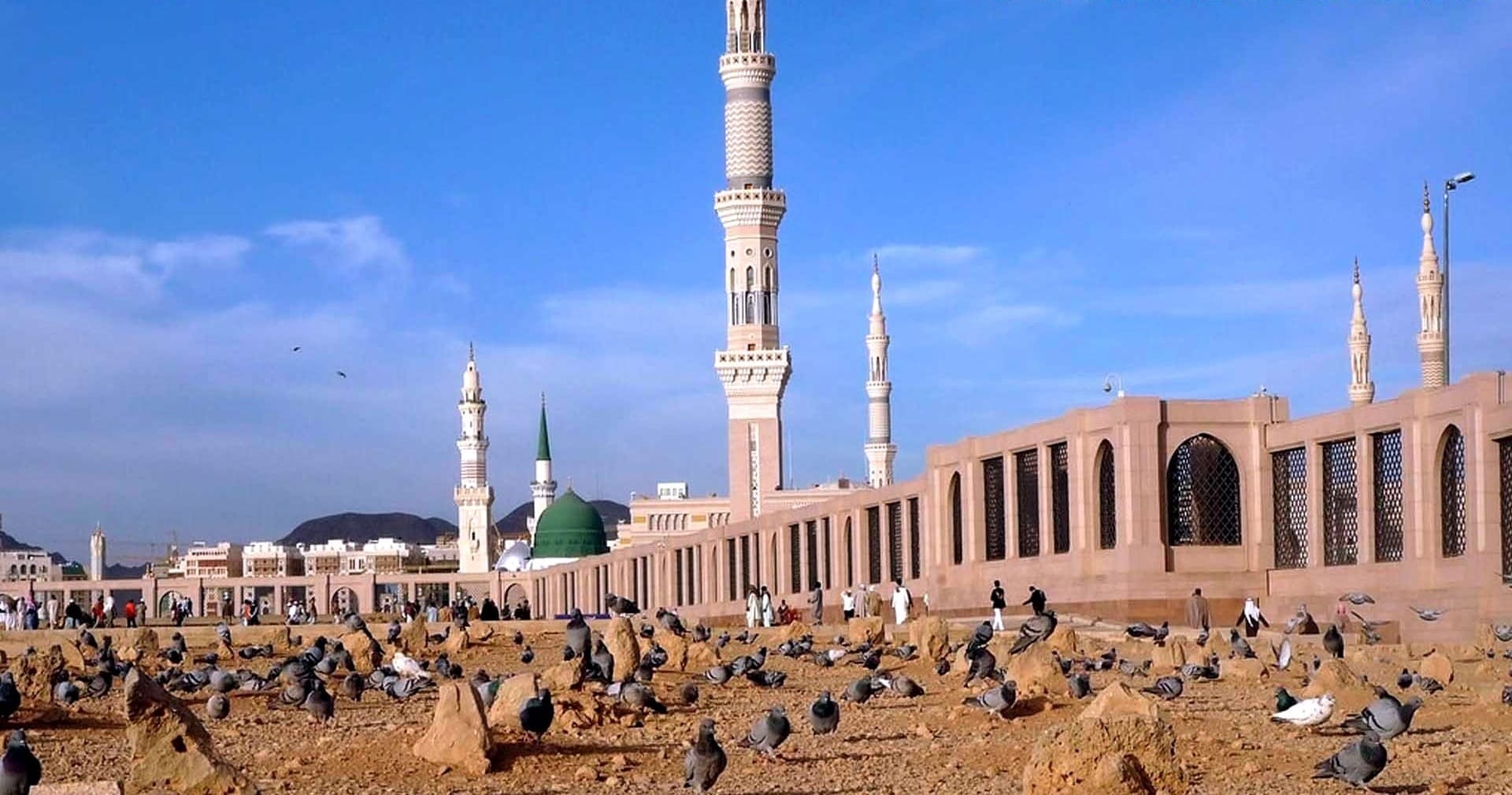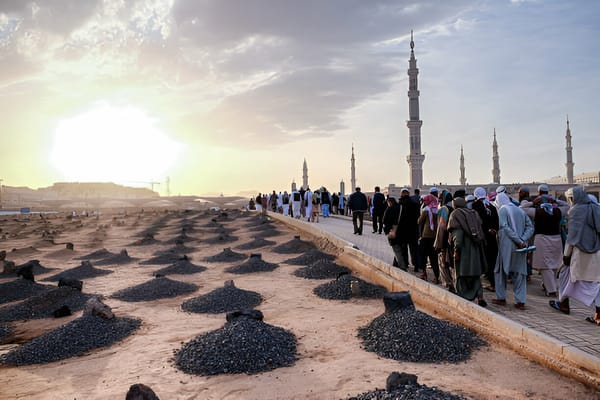Jannat al-Baqi, also known as Al Baqi Cemetery or Jannat Baqi, is one of the most sacred and historically rich sites in Madinah, Saudi Arabia. Located adjacent to the Prophet's Mosque (Masjid un-Nabawi), it is the final resting place of many of the Prophet Muhammad's (ﷺ) family members, companions, and key figures of early Islam. Visiting Al Baqi is a deeply spiritual experience, offering pilgrims a profound connection to Islamic heritage and the people who helped shape it.
For those planning their journey through Madinah’s landmarks, the Hop-On Hop-Off Bus is often recommended as a seamless and informative option, providing access to the key sites near Al Baqi while enhancing the overall ziyarat experience.
Historical Significance of Jannat al-Baqi
Origins and Early Use
The word "Baqi" means a tree garden, and the area was originally filled with boxthorn trees (Gharqad). The Prophet Muhammad (ﷺ) designated this land as a burial ground after his migration to Madinah in 622 CE. The first notable burial was that of As'ad ibn Zurarah, a companion of the Prophet, marking the beginning of Al Baqi as the primary Islamic cemetery in the city.
Growth of a Sacred Site
Over time, Al Baqi became the chosen site for the burial of many prominent figures from the Prophet's family and early Muslim community. Due to its location next to Al-Masjid an-Nabawi, the cemetery's sanctity grew, making it a significant place of remembrance and reflection.
Who's Buried in Al Baqi?
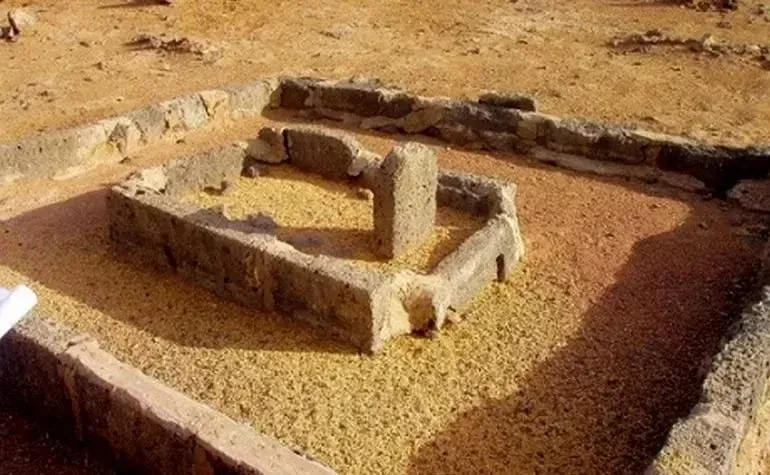
Al Baqi holds immense spiritual value because of the venerated souls resting there. These individuals are not only remembered for their roles in the early Islamic period but also for their unwavering faith and contributions.
Members of the Prophet's Family
- Fatimah al-Zahra – The beloved daughter of the Prophet (ﷺ) and wife of Ali ibn Abi Talib.
- Imam Hasan ibn Ali – Grandson of the Prophet and the second Imam in Shia Islam.
- Imam Ali Zayn al-Abidin – Great-grandson of the Prophet and the fourth Shia Imam.
- Imam Muhammad al-Baqir – Renowned for his knowledge and the fifth Shia Imam.
- Imam Ja'far al-Sadiq – A key figure in Islamic jurisprudence and the sixth Shia Imam.
Wives of the Prophet (ﷺ)
All of the Prophet’s wives, with the exception of Khadijah bint Khuwaylid and Maymunah bint al-Harith, are believed to be interred in Al Baqi. Among them:
- Aisha bint Abu Bakr – A scholar and prominent figure in Islamic history.
- Hafsa bint Umar – Daughter of Caliph Umar and a custodian of the Quranic manuscript.
Prominent Companions and Figures
- Uthman ibn Affan – The third Caliph and compiler of the Quran.
- Abbas ibn Abd al-Muttalib – The Prophet’s uncle.
- Abu Hurairah – The most prolific narrator of Hadith.
- Uthman ibn Maz'un – One of the earliest converts to Islam.
What to Recite When Visiting Jannatul Baqi
When visiting Jannatul Baqi, it is recommended to offer du'a (supplication) and greetings of peace to the souls resting there. A well-known supplication is:
"Assalaamu 'alaikum ahl ad-diyaari minal-mu'mineena wal-muslimeena, wa innaa inshaa' Allahu bikum laahiqoon, nas'alullaha lanaa wa lakumul 'aafiyah."
Translation: Peace be upon you, O inhabitants of the dwellings, among the believers and the Muslims. Indeed, we are, Allah willing, soon to join you. We ask Allah for well-being for us and for you.
You may also recite Surah Al-Fatihah and pray for mercy and forgiveness for the deceased. Visiting with a pure heart and mindful intention is key to a spiritually fulfilling experience.
Architectural Changes and Demolitions
Historical Structures
For centuries, Al Baqi featured elegant mausoleums and domes erected over many of the graves, reflecting the esteem in which these personalities were held. These structures became pilgrimage points for Muslims across the world.
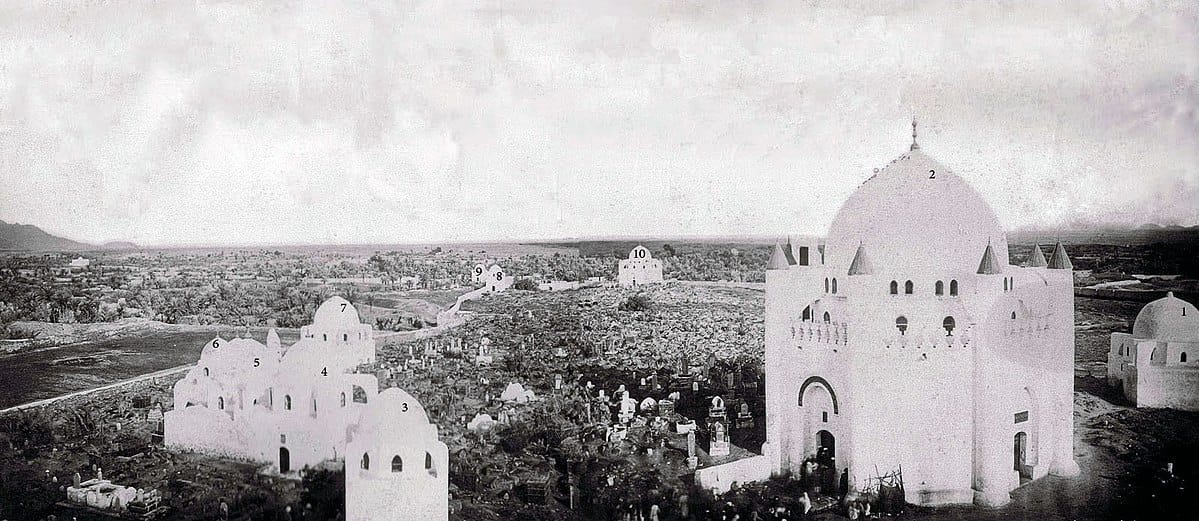
First and Second Demolitions
- 1806: The first major demolition was conducted by the early Wahhabi-Saudi alliance, aiming to eliminate practices deemed contrary to their interpretation of monotheism.
- 1925: After the establishment of the modern Saudi state, King Ibn Saud ordered the removal of all remaining structures. Today, graves are marked with simple mounds, in line with a minimalist interpretation of Islamic burial.
The Destruction of Al Baqi
The 1925 demolition of Al Baqi marked a significant turning point in the cemetery's history. While the ornate domes and markers that once adorned many of the graves were removed in efforts to uphold a purist interpretation of Islamic monotheism, the essence of Al Baqi's spiritual legacy endures. For many Muslims, especially those with deep reverence for Islamic history, this transformation is not only a moment of loss but also a testament to the enduring significance of simplicity and equality in Islamic burial traditions. Today, Al Baqi continues to inspire reflection, reverence, and a deeper connection to the humble origins of the faith.
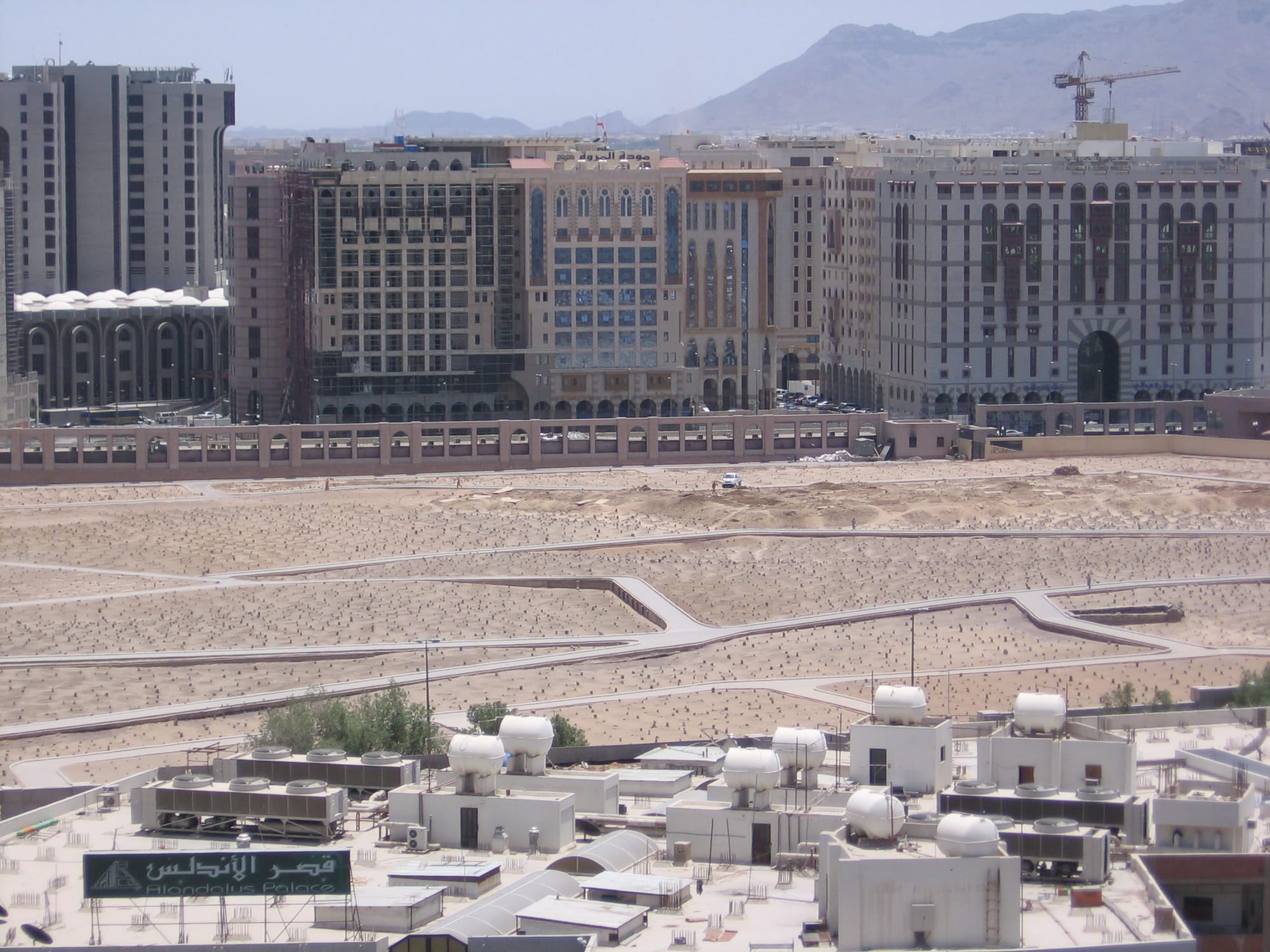
Can Anyone Be Buried in Jannatul Baqi?
Jannatul Baqi is a cemetery of immense religious and historical significance, and it is not open for general public burials. Burial in Al Baqi is typically reserved for residents of Madinah and is subject to strict regulations managed by the local religious authorities. Due to its spiritual importance and the prominent figures already interred there, the site remains a place of reverence rather than general use.
Going Inside Jannat ul-Baqi
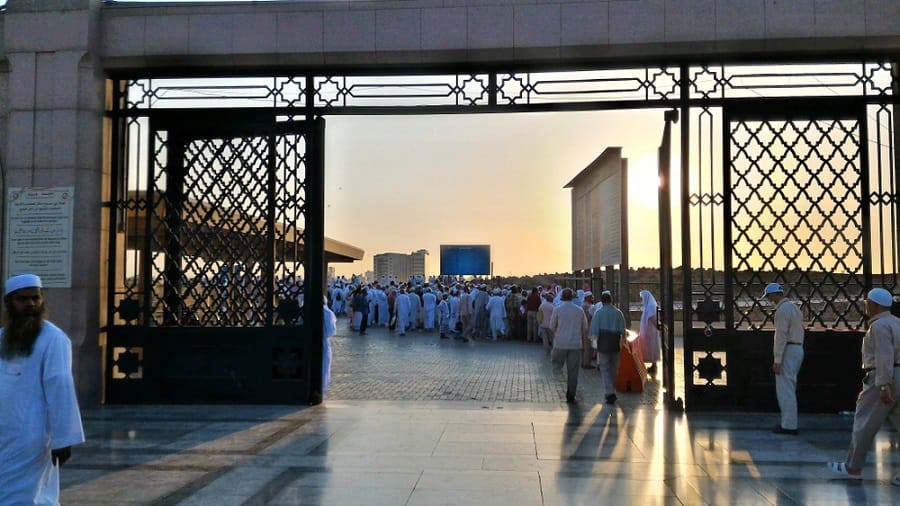
Visiting Hours
Al Baqi is generally open to male visitors during the following times:
- After Fajr (dawn prayer)
- After Asr (afternoon prayer)
Note: Timings can vary. Check with local sources for the latest updates.
Women are traditionally not allowed to enter the cemetery but can view it from designated areas just outside the enclosure.
Dress Code and Behavior
- Dress modestly – Ensure arms and legs are covered.
- Be silent and respectful – Refrain from loud conversations or unnecessary photography.
- Offer du’a (supplications) – Prayers for the souls resting here are encouraged.
What to Reflect On
- The simplicity of the cemetery emphasizes equality in death.
- Think about the lives, struggles, and legacies of those buried here.
- Allow time for quiet contemplation and personal prayer.
Getting There
The best way to reach the vicinity of Jannat al-Baqi is by using the Madinah Hop-On Hop-Off Bus. Stop 2 on the Red Route is specifically designated for Al Baqi, offering visitors a direct and informative way to arrive at this sacred site while learning about the city’s rich Islamic heritage along the way.
Alternatively, if you're already at Al-Masjid An-Nabawi, you can easily visit Al Baqi by foot. After your visit, you can continue or begin your Ziyarat journey by boarding the Hop-On Hop-Off Bus from either the Masjid Nabawi (Stop 1) or the Al Salam Gate (Stop 4).
Why the Red Route is an Ideal Option
Taking the Hop-On Hop-Off Bus to Stop 2 on the Red Route is usually the most practical and enriching way to access the area surrounding Jannat al-Baqi. Here’s why:
- Convenience: The route includes a direct stop near Al Baqi, making it an ideal drop-off point for visitors.
- Educational Value: Passengers benefit from onboard audio commentary detailing Madinah’s religious and historical sites.
- Scenic Overview: The bus offers panoramic views of the city, helping visitors orient themselves and appreciate the broader context of Islamic Madinah.
- Ease of Navigation: For first-time pilgrims, the clearly marked stops and route map simplify travel and reduce confusion.
Tips for a Meaningful Visit
- Learn beforehand: Knowing the history of Al Baqi and who is buried there can enrich your visit.
- Visit early: The morning hours are often more peaceful and less crowded.
- Respect boundaries: Follow all posted guidelines and instructions from local authorities.
- Combine with your itinerary: Consider using the Hop-On Hop-Off Bus to visit key Madinah attractions, then walk to Al Baqi for a reflective pause.
For a detailed route plan and guidance on how to visit key Madinah attractions using the Hop-On Hop-Off Bus, check out our dedicated guide: Discover 12 Must-Visit Sites in Madinah with the Hop-On Hop-Off Bus
Conclusion
A visit to Jannat al-Baqi is more than a historical stop—it’s a moment of deep spiritual reflection. This sacred site offers a tangible connection to the lives of those who lived closest to the Prophet Muhammad (ﷺ) and laid the foundations of Islam. Whether you're in Madinah for Umrah, Hajj, or personal exploration, take the time to pause, reflect, and honor the memories preserved in this tranquil corner of the city.
May the memories of those resting in Jannat al-Baqi continue to inspire your path.

